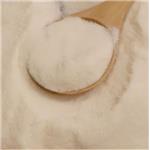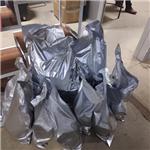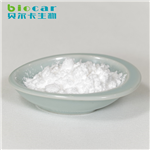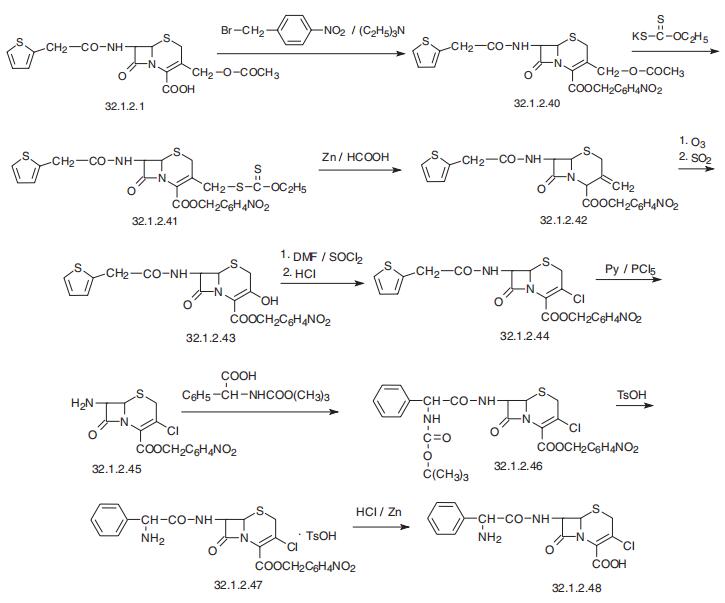- Cefaclor
-

- $0.00 / 1Kg
-
2024-04-09
- CAS:53994-73-3
- Min. Order: 1Kg
- Purity: 99%
- Supply Ability: 10kg
- Cefaclor
-

- $174.00 / 1kg
-
2023-03-21
- CAS:53994-73-3
- Min. Order: 1kg
- Purity: 99%
- Supply Ability: 5000 tons
- Cefaclor
-

- $1.00 / 10g
-
2022-12-29
- CAS:53994-73-3
- Min. Order: 10g
- Purity: 99.5%
- Supply Ability: 1000kg
|
| | Cefaclor Chemical Properties |
| Boiling point | 713.4±60.0 °C(Predicted) | | density | 1.3575 (rough estimate) | | refractive index | 1.6100 (estimate) | | storage temp. | under inert gas (nitrogen or Argon) at 2–8 °C | | solubility | 1 M HCl: 50 mg/mL, clear to very faintly turbid, yellow | | pka | pKa 1.5±0.2(H2O) (Uncertain) | | form | powder | | color | Crystal | | Water Solubility | 10g/L(temperature not stated) | | BRN | 8176092 | | BCS Class | 3 | | InChI | InChI=1S/C15H14ClN3O4S/c16-8-6-24-14-10(13(21)19(14)11(8)15(22)23)18-12(20)9(17)7-4-2-1-3-5-7/h1-5,9-10,14H,6,17H2,(H,18,20)(H,22,23)/t9-,10-,14-/m1/s1 | | InChIKey | QYIYFLOTGYLRGG-GPCCPHFNSA-N | | SMILES | N12[C@@]([H])([C@H](NC([C@H](N)C3=CC=CC=C3)=O)C1=O)SCC(Cl)=C2C(O)=O | | CAS DataBase Reference | 53994-73-3(CAS DataBase Reference) |
| Hazard Codes | Xn,Xi | | Risk Statements | 42/43 | | Safety Statements | 22-36/37-45 | | WGK Germany | 2 | | RTECS | XI0363000 | | HS Code | 29349990 | | Toxicity | TDLo orl-cld: 131 mg/kg/7D-I:MSK,SKN CMAJAX 126,1032,82 |
| | Cefaclor Usage And Synthesis |
| Brand Name(s) in US | Ceclor
| | Description | Cefaclor is a cephalosporin antibiotic that is active against S. pyogenes, S. pneumoniae, S. aureus, P. mirabilis, S. typhi, E. coli, and H. influenzae (MICs = 0.25, 0.25-2, 1-2, 1, 0.5, 1, and 2-4 μg/ml, respectively). It is protective against S. pyogenes, S. pneumoniae, S. aureus, P. mirabilis, S. typhi, E. coli, and H. influenzae infections in mice (ED50s = 0.08-30.2 mg/kg). Formulations containing cefaclor have been used in the treatment of various bacterial infections. | | Description | Cefaclor differs from cephalexin primarily in the bio-isosteric replacement of methyl by chlorine at C-3 and is
quite acid stable, allowing oral administration. It also is quite stable to metabolism. It is less active against
Gram-negative bacteria compared with the other second-generation cephalosporins but is more active
against Gram-negative bacteria compared with the first-generation drugs. | | Chemical Properties | white crystalline solid | | Originator | Ceclor,Lilly,US,1979 | | Uses | radioopaque agent | | Uses | Cefaclor is used to study urinary tract, intra-abdominal, and?Haemophilus influenzae?infections. It is used to study the mechanism of human renal organic anion and peptide transporters such as hOAT1, hPEPT1, and hPEPT2 and to study the effects of inhibition of penicillin-binding proteins on bacterial cell wall mucopeptide synthesis. | | Uses | Cefaclor belongs to the family of antibiotics known as the cephalosporins (cefalosporins). The cephalosporins are broad-spectrum antibiotics that are used for the treatment of septicaemia, pneumonia, meningitis, biliary-tract infections, peritonitis, and | | Definition | ChEBI: A cephalosporin bearing chloro and (R)-2-amino-2-phenylacetamido groups at positions 3 and 7, respectively, of the cephem skeleton. | | Manufacturing Process | Preparation of 7-amino-3-chloro-3-cephem-4-carboxylic acid: To a solution of
750 mg (185 mmol) of p-nitrobenzyl 7amino-3-chloro-3cephem-4-carboxylate
hydrochloride in 20 ml of tetrahydrofuran and 40 ml of methanol was added a
suspension of 750 mg of prereduced 5% palladium on carbon catalyst in 20
ml of ethanol and the suspension was hydrogenated under 50 psi of hydrogen
at room temperature for 45 minutes. The catalyst was filtered and washed
with THF and water. The filtrate and catalyst washes were combined and
evaporated to dryness, The residue was dissolved in a water-ethyl acetate
mixture and the pH adjusted to pH 3. The insoluble product was filtered and
triturated with acetone. The product was then dried to yield 115 mg of 7-
amino-3-chloro-3-cephem-4-carboxylic acid.
Preparation of 7-(D-α-phenylglycylamido)-3-chloro-3-cephem-4-carboxylic
acid: To a suspension of 280 mg (1.2 mmol) of 7-amino-3-chloro-3-cephem-
4-carboxylic acid in 14 ml of acetonitrile was added with stirring at room
temperature 0.5 ml of N,O-bis-(trimethylsilyl)acetamide to form the soluble
disilylmethyl derivative thereof. The solution was cooled to 0 C and was slowly
added to a solution of the mixed anhydride formed by reacting 408 mg (1.5
mmol) of methyl-3-α-carboxybenzylaminocrotonate sodium salt with 161 mg
(1.7 mmol) of methyl chloroformate in the presence to 2 drops of N,N-dimethylbenzyl amine in 7 ml of acetonitrile.
The mixture was stirred at ice bath temperature for 2 hours, 1 ml of methanol
was added and the mixture was filtered to remove insoluble impurities. Two
milliliters of water were added to the filtrate and the pH was adjusted
momentarily to pH 1.5, to effect removal of the enamine block, and then to
pH 4.5 with triethylamine. After stirring for an additional hour at ice bath
temperature the reaction product, 7-(D-α-phenylglycylamido)-3-chloro-3-
cephem-4-carboxylic acid (zwitterion) precipitated from the reaction mixture
as a crystalline solid. The product was filtered, washed with acetonitrile and
dried in vacuo to yield 200 mg.
| | Brand name | Ceclor (Lilly); Raniclor (Ranbaxy). | | Therapeutic Function | Antibiotic | | Antimicrobial activity | It is less resistant than other group 2 cephalosporins
to staphylococcal β-lactamase. It is active against
N. gonorrhoeae and H. influenzae and against most enterobacteria,
but it is susceptible to common enterobacterial
β-lactamases. Pr. vulgaris and Providencia, Acinetobacter and
Serratia spp. are resistant. B. fragilis and clostridia are resistant
but other anaerobes are commonly susceptible. | | Pharmacokinetics | Oral absorption: c. 90%
Cmax 250 mg oral: c. 6–7 mg/L after 50 min
Plasma half-life: 0.5–1 h
Volume of distribution: 0.37 L
Plasma protein binding: 25%
Absorption
Food intake increases the time taken to reach peak plasma
levels and reduces the peak by 25–50%. The actual amount
absorbed is unaffected. In children receiving 15 mg/kg per
day (maximum daily dose 1 g) the mean peak serum level was
16.8 mg/L at 0.5–1 h. There is no accumulation of the drug
during repeated administration.
Distribution
In patients receiving 500 mg every 8 h for 10 days, concentrations
were 0–1.7 (mean 0.5) mg/L in mucoid sputum and
0–2.8 (mean 1.0) mg/L in purulent sputum. In children with
chronic serous otitis media receiving 15 mg/kg per day, the
mean peak concentration in middle ear secretion was 3.8 mg/L
within 30 min of the dose when the mean simultaneous serum
concentration was 12.8 mg/L.
Metabolism and excretion
No metabolites have been identified, but the drug probably
chemically degrades in serum. About half of the dose is recovered
from the urine in the first 6 h and 70% in 24 h. Probenecid
prolongs the plasma levels but in renal insufficiency the plasma
half-life is only moderately increased. In patients with creatinine
clearance values of 5–15 mL/min the mean plasma elimination
half-life rose to 2.3 h and the 24 h urinary excretion fell to less than 10%. In patients requiring intermittent hemodialysis
and receiving 500 mg every 8 h for 10 days, the half-life rose
to 2.9 h. Dialysis removed 34% of the dose | | Clinical Use | Cefaclor (Ceclor) is an orally active semisyntheticcephalosporin that was introduced in the American market in1979. It differs structurally from cephalexin in that the 3-methyl group has been replaced by a chlorine atom. It issynthesized from the corresponding 3-methylenecepham sulfoxideester by ozonolysis, followed by halogenation of theresulting β-ketoester. The 3-methylenecepham sulfoxideesters are prepared by rearrangement of the corresponding 6-acylaminopenicillanic acid derivative. Cefaclor is moderatelystable in acid and achieves enough oral absorption to provideeffective plasma levels (equal to about two-thirds of thoseobtained with cephalexin). The compound is apparentlyunstable in solution, since about 50% of its antimicrobial activityis lost in 2 hours in serum at 37°C. The antibacterialspectrum of activity is similar to that of cephalexin, but it isclaimed to be more potent against some species sensitiveto both agents. Currently, the drug is recommended for thetreatment of non–life-threatening infections caused by H.influenzae, particularly strains resistant to ampicillin. | | Clinical Use | Uses are similar to those of other group 2 cephalosporins.
It is among the few suitable for use in respiratory infections
because of its activity against H. influenzae. | | Side effects | Apart from mild gastrointestinal disturbance, the drug is
well tolerated. Transiently increased transaminase levels and
symptomatic vaginal candidosis have been noted. Clusters of
a serum sickness-like illness have been described in children. | | Safety Profile | Moderately toxic by intraperitoneal route. Human systemic effects by ingestion: joints, dermatitis, increased body temperature. An experimental teratogen. Experimental reproductive effects. When heated to decomposition it emits toxic fumes of Clí, SOx, an | | Synthesis | Cefaclor, (6R,7R)-7-[(R)-2-amino-2-phenylacetamido]-3-chloro-8-oxo-5-thia-
1-azabicyclo[4.2.0]oct-2-en-2-carboxylic acid (32.1.2.48), is synthesized from the most accessible antibiotic of
this series, cefalotin (32.1.2.1), in which the carboxyl group is protected by esterification by
a reaction with 4-nitrobenzylbromide in triethylamine, giving the 4-nitrobenzyl ester of
7-(2-thienylacetamido)-cephalosporanic acid (32.1.2.40). Reacting this with potassium
ethyl xantogenate replaces the acetoxy group in the third position of the cephalosporin sys�tem, giving the corresponding S-derivative (32.1.2.41). Upon reducing this compound using
zinc in formic acid, the product is desulfurized, giving the 4-nitrobenzyl ester of
3-exo-methylen-7-(2-thienylacetamido)-cefem-4-carboxylic acid (32.1.2.42). The exo�methylene group is oxidized by ozone and the resulting dicarbonyl derivative tautomerizes
to the enol form (32.1.2.43) upon reaction with sulfur anhydride. Then, the hydroxyl group
is replaced with a chlorine atom upon reaction with thionyl chloride, giving the 4-nitroben�zyl ester of 3-chloro-7-(2-thienylacetamido)-3-cefem-4-carboxylic acid (32.1.2.44). The
resulting product undergoes deacylation upon reaction with a mixture of pyridine with
phosphorous pentachloride in isobutanol, forming the hydrochloride of 4-nitrobenzyl ester
of 7-amino-3-chloro-3-cefem-4-carboxylic acid (32.1.2.45). This is acylated with an
N-protected derivative of phenylglycine, (N-tert-butoxycarbonyl)-D-|á-phenylglycine in the
presence of N-ethoxycarbonyl-2-ethoxy-1,2-dihydroquinoline in tetrahydrofuran, giving the product (32.1.2.46). The tert-butoxycarbonyl protection in this molecule is removed by
heating in acetonitrile in the presence of p-toluenesulfonic acid. Finally, upon hydrogen
reduction using zinc and hydrochloric acid in dimethylformamide, the 4-nitrobenzyl pro�tecting group is removed from the resulting tosylate (32.1.2.47) giving cefaclor (32.1.2.48). 
| | Veterinary Drugs and Treatments | Cefaclor may potentially be useful when an oral cephalosporin is
desired to treat infections that are susceptible to it but resistant to
first generation cephalosporins such as cephalexin or cefadroxil.
Little information is available with regard to its clinical use in small
animals, however. | | Drug interactions | Potentially hazardous interactions with other drugs
Anticoagulants: effects of coumarins may be
enhanced. | | Metabolism | Cefaclor is rapidly excreted by the kidneys; up to 85% of
a dose appears unchanged in the urine within 8 hours, the
greater part within 2 hours. Probenecid delays excretion |
| | Cefaclor Preparation Products And Raw materials |
|